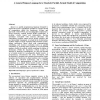287 search results - page 39 / 58 » On Exploiting Task Duplication in Parallel Program Schedulin... |
CORR
2010
Springer
13 years 8 months ago
2010
Springer
Space is a spatial programming language designed to exploit the massive parallelism available in a formal model of computation called the Synchronic A-Ram, and physically related ...
LCPC
2004
Springer
14 years 2 months ago
2004
Springer
Abstract. Parallel loops account for the greatest percentage of program parallelism. The degree to which parallelism can be exploited and the amount of overhead involved during par...
SAMOS
2009
Springer
14 years 3 months ago
2009
Springer
We believe that future many-core architectures should support a simple and scalable way to execute many threads that are generated by parallel programs. A good candidate to impleme...
ICCAD
2001
IEEE
14 years 5 months ago
2001
IEEE
Tight data- and timing constraints are imposed by communication and multimedia applications. The architecture for the embedded processor imply resource constraints. Instead of ran...
ASPLOS
1992
ACM
14 years 22 days ago
1992
ACM
The foremost goal of superscalar processor design is to increase performance through the exploitation of instruction-level parallelism (ILP). Previous studies have shown that spec...

